Fresh Air Solutions: 5 Best Air Purifiers for Cooking Smells
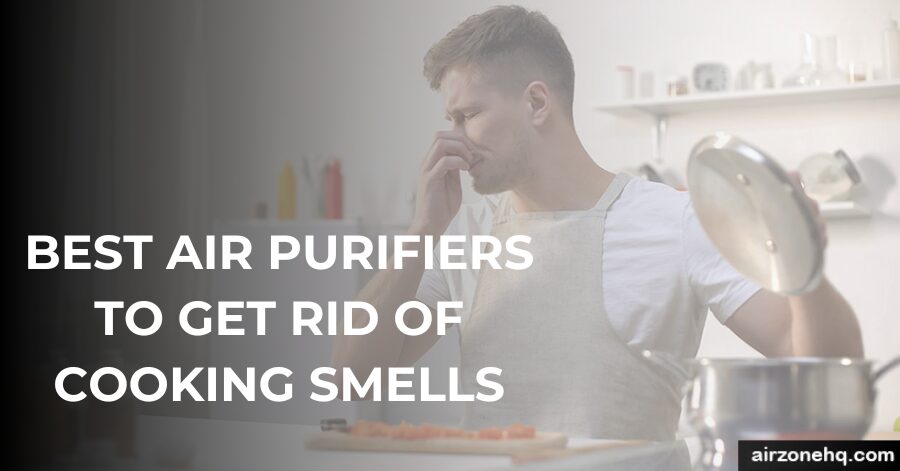
A variety of air purifiers that are ideal for maintaining fresh, clean air in your kitchen
Nothing makes people feel more hungry than the enticing aroma of a home-cooked supper. The occasional accident does happen, though; perhaps something got a little too crispy, or the house started to smell like onions. In these circumstances, things become a little more complex.
However, unpleasant, lingering odors are only half the issue. Cooking and using kitchen appliances can generate indoor air pollution in a quiet way. It is possible for smoke to spread, gas stoves to release chemicals like formaldehyde and carbon monoxide, and cooking itself to generate a mixture of particles, nitrogen dioxide, and volatile organic compounds (VOCs) that have an unpleasant smell.
Table of Contents
Achieving a healthier kitchen environment begins with selecting the best air purifier for your needs and avoiding unintentional exposure to these dangerous contaminants. Click here to see best air purifier for weed Smoke.
We have tested 56 different air purifiers for cooking smells thoroughly and manually since 2021 in order to gather unique data on features, sound levels, air cleaning effectiveness, and long-term expenses. The best air purifiers, in our opinion, for eliminating cooking scents have been determined using this data.
Using all of this information, we have examined every air purifier we have evaluated and have identified the key components needed for an air purifier to effectively remove cooking odors.
We chose air purifiers for cooking smells that have the following:
- Activated carbon filters. Activated carbon uses a process called adsorption to eliminate cooking gasses and odors.
- HEPA filters or similar primary filters. The tiny particles of smoke produced during baking, frying, roasting, and cooking can be eliminated using a HEPA filter.
- Fast air cleaning performance. Cooking smoke will adhere more to your clothing and any soft furnishings in the kitchen the longer it is present in the air.
- Onboard air quality sensor and auto mode. There are moments when your hands are full from whatever you are doing. An air purifier that turns on automatically in response to changes in air quality is essential at those times.
- Good CADR for the price. Since it might be challenging to clear up pollutants like kitchen smoke from roasting or frying food, we searched for strong air purifiers with a high clean air delivery rate.
- Fair long-term. To gain a comprehensive picture of the cost of filter replacements and the increase in your electricity bill, we investigate the prices of authentic and generic filters.
Staff picks: Top 3 kitchen air purifiers
Time is, in fact, a valuable resource. These are our top three reliable air purifiers for cooking smells for eliminating kitchen scents.
| BEST OVERALL | BEST FOR SMALL BUDGETS | FOR LARGE KITCHENS | |
| Shark HP102 | Levoit Core 300S | Alen BreatheSmart | |
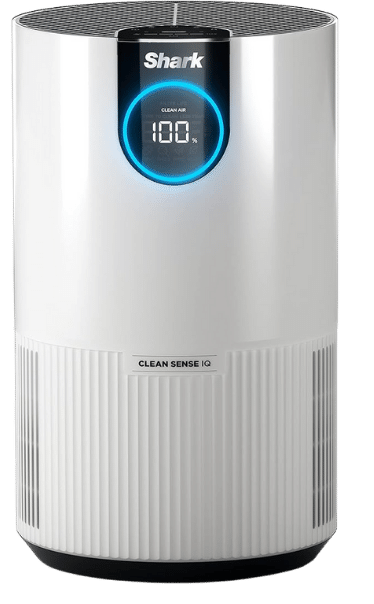 |  | 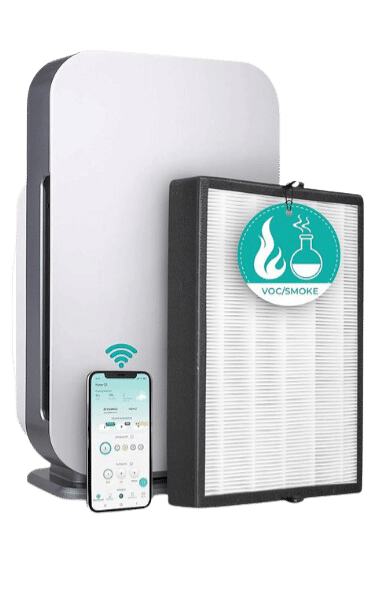 | |
| Air cleaning speed | 38 minutes | 39 minutes | 33 minutes |
| CADR rating | 92 CFM | 141 CFM | 245 CFM |
| Filter technology | NanoSeal™ filter with activated carbon | 3-stage filtration with activated carbon | True HEPA H13 filters with activated carbon + ionizer |
| Max room size | 500 sq. ft. | 219 sq. ft. | 800 sq. ft. |
| Weight | 5.85 lbs (2.7 kg) | 5.95 lbs (2.7 kg) | 9.1 kg (20.1 lbs) |
| More Detail |
After reading through our top picks, let’s look at the complete list of air purifiers for cooking smells designed especially to eliminate cooking smells.
We’ve assembled a variety of units in this comprehensive guide, each one made to fit a distinct set of requirements and price ranges. Every kitchen can have the ideal cleaner, ranging from high-tech models to more affordable choices.
1. Best overall: Shark HP102
Is this the killer app for the Levoit Core 300S? Along with a must-have smart feature set and an accurate onboard air quality sensor, the HP102 provides exceptional air cleaning performance.
The HP102 is the company’s first air purifier. SharkNinja is the company behind the well-known Ninja air fryers and blenders, so it’s not surprising to find another top-notch kitchen equipment from them!
A new force in the world of air purifiers for cooking smells, the Shark HP102 boasts a lightweight body, an efficient auto-mode, and a CADR score comparable to that of the Core 300. When I first opened the package, I was pleased with how it looked, but what truly won me over was how well it cleaned the air.
The HP102 has a Shark NanoSealTM filter for filtration. The Microban® coating on this True HEPA filter inhibits the formation of bacteria, making it especially useful in the kitchen. It’s also well-suited to deal with kitchen scents thanks to its pelletized high-efficiency activated carbon.
What we really like
- 👍 Great air cleaning performance — cleaned our test room in 38 minutes, that’s one full minute faster than the Core 300S and two minutes faster than the Core 300.
- 👍The control panel screens and the display are both of outstanding quality.
- 👍 When it detects contaminants, the air quality sensor is incredibly accurate and makes immediate adjustments.
- 👍 There are lots of cheaper generic filters available.
What we think could be better
- It isn’t compatible with smartphone apps.
As you are aware, we evaluate every air purifier we suggest by timing how quickly it can remove dense incense smoke from the air inside our 728-square-foot home lab. Based on its CADR rating, the HP102 outperformed my expectations in that test; it cleaned the air a full minute faster than our previous top selection for kitchens, the Core 300S.
The Shark HP102 has two stylish screens, one for controlling the many operations of the machine and displaying the kitchen’s current air quality condition, together with an accurate onboard air quality sensor and excellent air cleaning speed.
Despite lacking app integration, the HP102 makes up for it with two useful modes: Auto and Eco. When the HP102 detects clean air, it smoothly switches from Auto Mode to Eco Mode. This kind function comes in especially useful after a culinary session. After conscientiously cleaning the air, the HP102 switches to Eco Mode to prolong the life of the filter and let you enjoy your food without worrying about the air purifiers for cooking smells.
sPECS & FEATURES
| AirZoneHQ Rating: | ★★★★★ |
| Time to clean our test room: | 38 minutes |
| Air purifier technology: | NanoSeal™ Filter (True HEPA Multi-Filter with Microban® antimicrobial coating) |
| Recommended room size: | 500 sq. ft. (but it can only do 1.38 ACH so we recommend a minimum of 200 sq. ft.) |
| Clean air delivery rate (CADR): | 92 CFM |
| Dimensions (in inches / in cm): | 8.66D x 8.66W x 14.56H inches (22D x 22W x 27H cm) |
| Weight (in pounds / in kg): | 5.85 lbs (2.7 kg) |
| Noise level (low – high): | 41.7 – 56.5 dB |
| Filter life: | 6-12 months |
| Warranty: | 2 year limited warranty |
| Estimated energy consumption: | $25.23 per year |
| Country of manufacture: | China |
2. Best budget option: Levoit Core 300S
In the kitchen, the Levoit Core 300S is like a reliable companion. It provides an affordable way to raise the quality of the air in your kitchen without sacrificing power or compactness.
In less than 39 minutes, the Core 300S eliminated airborne particles and contaminants from the room during our practical test. Given the unit’s size and cost, the high CADR (Clean Air Delivery Rate) and strong fan are largely responsible for this accomplishment.
It can cover up to 219 square feet and filter the air in an average-sized kitchen.
The well-known three-stage filtration mechanism that is the signature of the Levoit Core series is present in the Core 300S. The primary airborne particle filter comes first, then a nylon pre-filter. Together, these two are particularly capable of capturing smoke particles from cooking as well as other tiny particles like pollen and fine dust. It also uses a high-performance activated carbon filter to fight lingering cooking smells and volatile organic compounds.
What we really like
- 👍 Activated charcoal made with pelleted carbon is superior to impregnated cloth found in other low-cost brands.
- 👍 Auto-mode responds quickly to any airborne particles produced during cooking.
- 👍 Its 360-degree design enables it to draw air from the entire kitchen.
- 👍 One of the best on the market in terms of performance to $
- 👍 The availability of a wide variety of generic filters results in extremely inexpensive long-term operating expenses.
What we think could be better
- While generic filters can be purchased for less than $30, genuine filters cost $50.
- The pre-filter cannot be removed for cleaning, and some users notice a faint wine flavor at lower fan speeds. Using it in auto-mode makes this less of a problem, but it’s still worthwhile to watch the review’s video of it in action.
Additionally, the 300S has Levoit’s AirSight PlusTM technology, which shows the air quality in your kitchen on the control panel as an easy-to-use, color-coded light ring. With the integrated air sensor, you can also use the auto mode, which lets you concentrate on cooking while the Core 300S automatically modifies its fan speed to suit the requirements of your kitchen. After a lengthy period of use in my kitchen, I discovered that the sensor adjusted quite rapidly, so you didn’t always need to have it on to swiftly address problems.
Similarly, the app support also simplifies interaction. You can use your hands on dough to control it when you connect it to Google Assistant and Amazon Alexa.
SPECS & FEATURES
| AirZoneHQ Rating: | ★★★★★ |
| Time to clean our test room: | 39 minutes |
| Air purifier technology: | 3-Stage Filtration (Pre-filter for large particles, main filter for airborne particles, high-efficiency activated carbon filter for odors and gasses) |
| Recommended room size: | 219 sq. ft. |
| Clean air delivery rate (CADR): | 141 CFM (240 m³) |
| Dimensions (in inches / in cm): | 8.7L x 8.7W x 14.2H inches (22L x 22W x 36H cm) |
| Weight (in pounds / in kg): | 5.95 lbs (2.7 kg) |
| Noise level (low – high): | 24 – 48dB |
| Filter life: | 6 – 8 months |
| Manufacturer’s warranty | 2 years |
| Estimated energy consumption: | $52.56 |
| Country of manufacture: | China |

3. Best for small kitchens: Levoit Core 200S
The smaller sibling of the Core 300S, which retails for less than $100 and has excellent performance in kitchens up to 183 square feet in size.
Similar to the younger sibling of the Core 300S, the Levoit Core 200S has many of the same functions, while it differs slightly in terms of size, power, beginning cost, and electricity consumption. The way this little purifier—which costs less than $100—manages to include intelligent features often found in more expensive, bulkier models still amazes me.
The performance of the 200S is unaffected by its reduced size. This air purifiers for cooking smells, like the Core 300S, has Levoit’s three-stage filtration system, which consists of a main airborne particle filter, a pellet-based carbon filter, and a nylon pre-filter. This combination is great for removing cooking pollutants and odors that are common in small kitchens.
What we really like
- 👍Since it’s the smallest item on the list, small kitchens can accommodate it snugly.
- 👍Because of its extreme quietness, you won’t be distracted when preparing dinner.
- 👍The control panel is simple to use and straightforward.
- 👍It has clever features like app integration through the Vesync app that are uncommon for this price range.
What we think could be better
- cannot be utilized in auto mode and lacks an air quality indication.
- The filter ends up costing about the same as the Levoit Core 300, but it has less ability to clean the air.
Having a significantly lower CADR of 118 CFM than the 300S’s 141 CFM, the 200S is designed specifically for kitchens that are cozier. Because of its small size, it may fit neatly on countertops or next to cooking stations and mix in perfectly with your kitchen’s design.
Regretfully, the 200S lacks an air quality sensor and auto mode, in contrast to the 300S. On the other hand, the 200S leads in terms of filter replacement and energy consumption costs. Considering that it costs, on average, $30.48 a year instead of $52.56 to operate a 300S, it is noticeably more affordable.
Like the 300S, the Core 200S also has app support and is compatible with Google Assistant and Amazon Alexa. This implies that you can issue voice commands while continuing to cook. It’s a useful addition that’s quite handy when you’re preparing meals.
SPECS & FEATURES
| AirZoneHQ Rating: | ★★★☆☆ |
| Time to clean our test room: | 61 minutes |
| Air purifier technology: | Three-stage filtration: high-efficiency activated carbon filter for gasses and odors, pre-filter for big particles, and main filter for airborne particles |
| Recommended room size: | 183 sq. ft. |
| Clean air delivery rate (CADR): | 118 CFM |
| Dimensions (in inches / in cm): | 12.6H x 8.07W x 8.07D inches (32H x 20.5W x 20.5D cm) |
| Weight (in pounds / in kg): | 6.6 lbs (3 kg) |
| Noise level (measured from 3 ft. away): | Speed 1: 39.6 dB Speed 2: 43.7 dB Speed 3: 49.1 dB |
| Filter life: | 6 – 8 months |
| Electricity consumption (kilowatt-hour): | Standby mode: 1.1 kWh Speed 1: 19.3 kWh Speed 2: 22.6 kWh Speed 3: 28.4 kWh |
| Estimated running costs (electricity consumption + filter replacements): | $82.46 per year |
| Manufacturer’s warranty: | 2 years |
| Country of manufacture: | China |
4. Best for large kitchens: Alen BreatheSmart 45i
This air purifiers for cooking smells has a powerful fan that can pull air from kitchens up to 800 sq. ft. and clean it effectively thanks to its True HEPA filter with activated carbon.
The Alen 45i is the appliance I would always recommend if your kitchen is large and open-concept and odors can easily permeate the entire house. With its strong fan, this unit can extract air from spaces up to 800 square feet.
But even with its strength, it doesn’t occupy a lot of room. You can put this unit close to the wall because of the handy side air intake locations. This will save you the trouble of figuring out how to go around a big, heavy object in the middle of the kitchen when you’re rushing around.
What we really like
- 👍A color-coded air quality indicator on the user-friendly control panel makes it easier to view real-time updates on the temperature of your house from anywhere in the kitchen.
- 👍When selecting the Pure filter option, there is a high concentration of activated carbon pellets.
- 👍We don’t see this with other models, but setting the mode will save even if you unplug it.
- 👍Incredible air cleaning performance: in just 33 minutes, our test room was cleaned.
- 👍auto-mode that modifies fans in response to the quantity of particles the onboard sensor detects Lifetime warranty when you have an active filter subscription
What we think could be better
- Although they cost a bit extra, filters can last up to a year.
- More expensive than budget air purifier companies, but higher built quality and more features
There are several filter options available for Alen air purifiers, including Pure, Fresh, OdorCell, and Smoke filters, for individuals who are new to the brand. The Smoke filter could be too much for common kitchen scents, while the Pure filter is the only one without activated carbon. Choosing OdorCell or Fresh filters should be adequate. To address even the most obstinate kitchen odors, I would advise choosing the OdorCell filter.
Ionizing technology is also integrated into the 45i, which can improve its functionality even more. In our experiments, the 45i was able to clear our test room in just 33 minutes by using the HEPA and activated charcoal filters in the ionizer. But since the 45i is more than adequate without the ionizer, I would rather have faith in its powers.
SPECS & FEATURES
| AirZoneHQ Rating: | ★★★★☆ |
| Time to clean our test room: | 33 minutes |
| Air purifier technology: | True HEPA H13 filters with activated carbon pellets + Ionizer technology |
| Recommended room size: | Up to 800 sq. ft. |
| Clean air delivery rate (CADR): | 245 CFM (416 m³/h) |
| Dimensions (in inches / in cm): | 25H x 15W x 8.5D inches (63.5H x 38.1W x 21.6D cm) |
| Weight (in pounds / in kg): | 20.1 lbs (9.1 kg) |
| Noise level (measured from 3 ft. away): | Speed 1: 36.2 dB Speed 2: 45.7 dB Speed 3: 51.1 dB |
| Filter life: | 12 months |
| Electricity consumption (kilowatt-hour): | Standby mode: 0.8 kWh Speed 1: 4.4 kWh Speed 2: 7.4 kWh Speed 3: 15.2 kWh Speed 4: 25.3 kWh |
| Estimated running costs (electricity consumption + filter replacements): | $105.40 per year |
| Manufacturer’s warranty: | Lifetime (with product registration & active filter subscription) |
| Country of manufacture: | China |
5. Best for smart kitchens: Mila Air Purifier
Mila is a smart gadget with exceptional air cleaning capabilities that is more than simply an air purifier for your kitchen. It is easily accessible, easy to use, and simple.
This unit is distinguished by its organic forms and wooden legs, as well as by its distinct collection of clever functions and simple, emoji-filled language devoid of technical terms.
With this smart air purifiers for cooking smells, you’re investing in both performance and practical automated functions, even though the price is a little higher. The Mila is undoubtedly a useful addition to your kitchen if you appreciate a simple, hands-free option.
In terms of filters, I’ve discovered that a minimum of 0.5 kg of activated carbon is essential for eliminating kitchen scents. Mila provides a wide selection of filters since she recognizes this. You can rely on Mila to continuously keep the air in your kitchen fresh, regardless of whether you prefer the Rookie Parent filter, which has an H12 HEPA filter and 0.70 lb of activated carbon, or the Critter Cuddler, which has an H13 HEPA filter and 0.84 lb of activated carbon.
What we really like
- 👍Really intelligent, it utilizes its numerous inbuilt sensors to sense the air quality in your house and communicates to a central server.
- 👍The app has a beautiful user interface, and adding more milas to clean the air in your house is simple.
- 👍This model’s ability to change the vent angles is special.
- 👍An attractive gadget that might fit in a contemporary living room
- 👍Many filter options available for purchase, allowing you to customize for your own circumstances
What we think could be better
- Filter expenses are slightly more than those of comparable powered machines.
- If you don’t care about the extra smart features, it’s best to avoid because you pay more for them.
The automated mode on the Mila is really amazing. It has eight distinct settings, each with adjustable fan speeds, noise levels, and energy efficiency ratios to suit various applications. Its eight integrated air quality sensors are amazing; this is more than your typical purifier. This implies that Mila will adjust by sensing changes in its environment and, for example, go into overdrive while you’re cooking.
However, the Mila doesn’t end there. While many devices concentrate on basic particle measures such as PM1.0, PM2.5, and PM10, this unit goes one step further by detecting volatile organic compounds (VOCs). This capability is revolutionary, especially in kitchens where residual cooking fumes are common.
SPECS & FEATURES
| AirZoneHQ Rating: | ★★★★☆ |
| Time to clean our test room: | 35 minutes |
| Air purifier technology: | HEPA (ranges from H12-H14) + Activated charcoal (granular carbon) |
| Recommended room size: | 1000 sq. ft. |
| Clean air delivery rate (CADR): | 263 CFM (447 m³/hr) |
| Dimensions (in inches / in cm): | 12L x 12W x 15H inches (30.48L x 30.48W x 38.1H cm) |
| Weight (in pounds / in kg): | 18 lbs (8 kg) |
| Noise level (low – high): | 24dB – 74dB |
| Filter life: | 6 months |
| Manufacturer’s warranty: | 1 year |
| Estimated energy consumption: | $52.56 per year |
| Country of manufacture: | China |
We tested other units, but we don’t advise them for cooking smells
- Levoit Core 300: Although we love the original Core 300, its absence of auto-mode makes it unsuitable for cleaning up sporadic spills in the kitchen.
- AROEVE MK01: One of the most well-known air purifiers available is the AROEVE MK01, but in our tests, it did a very poor job of eliminating contaminants from our relatively modest test lab.
- Molekule Mini: Although it has an excellent design, it did not function well in our home lab performance test. It reached a maximum volume of 86dB, which is much too loud to be used in a kitchen.
- Okaysou AirMax 10L Pro: Due of its impact on TikTok campaigns, this product became another best-seller; however, in our tests, it performed far worse than we would have predicted given its stated CADR. We have significantly less faith in this brand than in the others we have highlighted because of their misleading marketing for their 5-in-1 filter technolog.
- Blueair Blue Pure 411+: Although the HEPASilent technology of this tiny air purifier removes pollutants really quickly, we don’t like that using an ionizer is required. We further object to their creation of an entirely new version that does not make use of the previous filters.
things you should know before buying best air purifiers for cooking smells
Numerous studies demonstrate that indoor pollutants such as smoke, volatile organic compounds VOCs, nitrogen dioxide and particulate matter are mostly produced in kitchens. When choosing an air purifiers for cooking smells, it’s important to take the time to make sure it will effectively keep your air clean while you cook.
You should prioritize air purification since health professionals warn that prolonged exposure to poor-quality air can have a severe influence on your health.
You should prioritize air purification since Health experts warn that prolonged exposure to poor-quality air can have a severe influence on your health.
You should think about the size of your cooking area, the kind of filter, and any features you absolutely must have when selecting the best air purifier for your kitchen.
1. Go for high-quality HEPA and activated carbon filters
In terms of ultrafine particle filtration, High-efficiency particulate air (HEPA) filters are the industry standard. They have been demonstrated to eliminate 99.97% of airborne particles in a specified space.
However, as scents are naturally occurring chemicals or gases, HEPA technology is unable to filter them. Through a process known as adsorption, activated carbon addresses that.
As such, going for a device that has both filters installed will guarantee maximum efficiency.
2. Consider the size of your kitchen
The size of the room where the air purifiers for cooking smells will be utilized is one of the most important considerations when purchasing one. No matter how much energy a product uses, you want to buy something that will work as efficiently as possible.
Choosing an air purifier that is too small for a particular room is a common mistake. Insufficient size or power will cause the unit to use filters more than necessary and leave the area unclean.
The Clean Air Delivery Rate (CADR) rating of the air purifiers for cooking smells is something to take into account. How much clean air the unit can produce in a given amount of time is shown by the CADR rating. Although CADR is an industry statistic, it’s important to note that some manufacturers do not provide their data, therefore it’s important to look at independent tests like the ones that AirZoneHQ does.
Generally speaking, an air purifiers for cooking smells should have a CADR rating that covers at least two thirds of the kitchen area. Thus, for instance, if your kitchen is 240 square feet in size, you should choose a device with a minimum CADR value of 160.
As an alternative, every well-known manufacturer in the air purifiers for cooking smells industry will recommend a room size for each unit based on two air changes per hour; just make sure it fits your demands.
3. Consider incorporating an inbuilt air quality sensor to enable intelligent functions
It is unlikely that you will be able to put your air purifier on or adjust the fan settings while you are cooking.
When an air quality sensor in an air purifiers for cooking smells detects a change in the air, such as when you open the oven and a cloud of smoke enters the kitchen, the purifier can begin operating automatically in the background.
You can monitor the air quality in your kitchen in real time with some smart air purifiers by controlling them via a mobile app.
4. Take into account the original unit cost but account for ongoing expenses and replacement filters
The cost of an air purifiers for cooking smells might be high. Thus, take into account all related costs in addition to the device’s initial purchase price. This covers continuing costs for filter replacements as well as the energy needed to run the machine.
The operating costs and suggested frequency of filter replacement for each unit are listed in our specifications table.
conclusion
To sum up, choosing the best air purifiers for cooking smells to get rid of cooking odors is essential to keeping a kitchen that is healthy. You can choose wisely if you prioritize features like HEPA and activated carbon filters, take your kitchen’s size into account, install an integrated air quality monitor, and assess recurring costs. Achieving clean, fresh air in your kitchen is now easier than ever with our best choices and thorough guidance. Make thoughtful decisions and always have a fun time cooking.
FAQ’s
Do air purifiers remove cooking odor?
The answer is yes, cooking smells can be effectively eliminated by using air purifiers with activated carbon filters. Fresher air may be found indoors thanks to these filters, which capture offensive molecules, including those produced during cooking. HEPA filters may also collect microscopic particles released during cooking, improving the quality of the air even more. Purchasing an air purifier can greatly enhance indoor air quality and effectively eliminate lingering cooking odors.
How do I keep my house from smelling when cooking?
Consider the following advice to avoid cooking smells in your house. (1) Utilize exhaust fans or open windows to get fresh air into your kitchen. (2) cover cooking utensils tightly. (3) boil water in a pot with lemon slices and seasonings. (4) clean your kitchen surfaces frequently. (5) get an air purifier that can remove odors. You can maintain a fresh kitchen scent while cooking by following these easy steps.
Can air purifiers remove smells?
Indeed, air purifiers work well at eliminating odors from interior spaces. They use a variety of filtering methods, such as airborne activated carbon filters that draw in smells and volatile organic compounds (VOCs). Air purifiers greatly enhance the general freshness and cleanliness of your living area by removing and capturing odor-causing particles.
What can absorb cooking smells?
Cooking odors can be efficiently absorbed using a variety of techniques. Using natural odor absorbers such as baking soda or activated charcoal and placing them in strategic locations throughout the kitchen is one way. Odors can also be eliminated by simmering a pot of water with vinegar and citrus peels. Using exhaust fans or opening windows to provide proper ventilation also aids in the rapid dispersal of cooking odors.



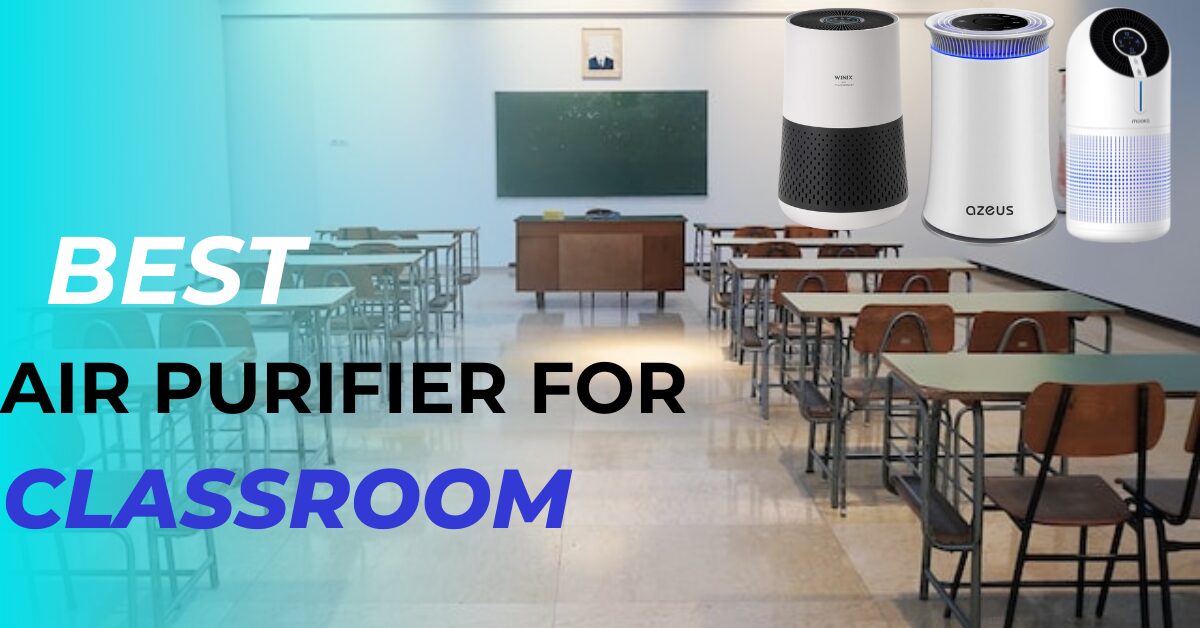


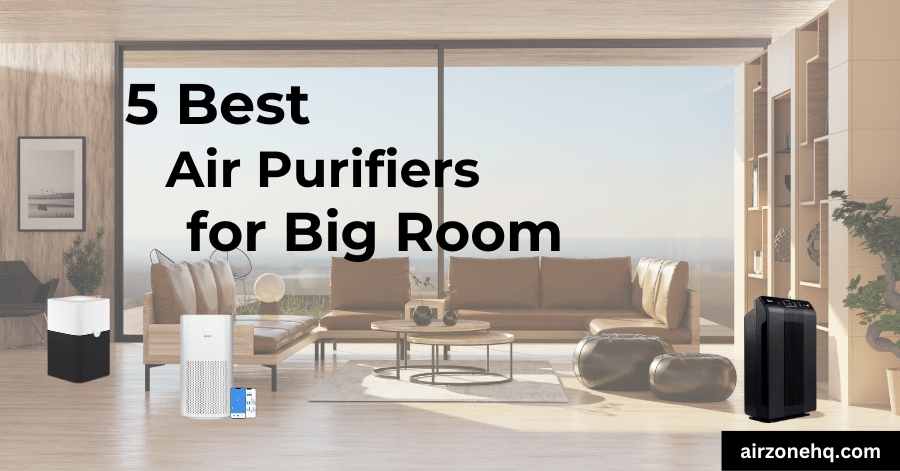

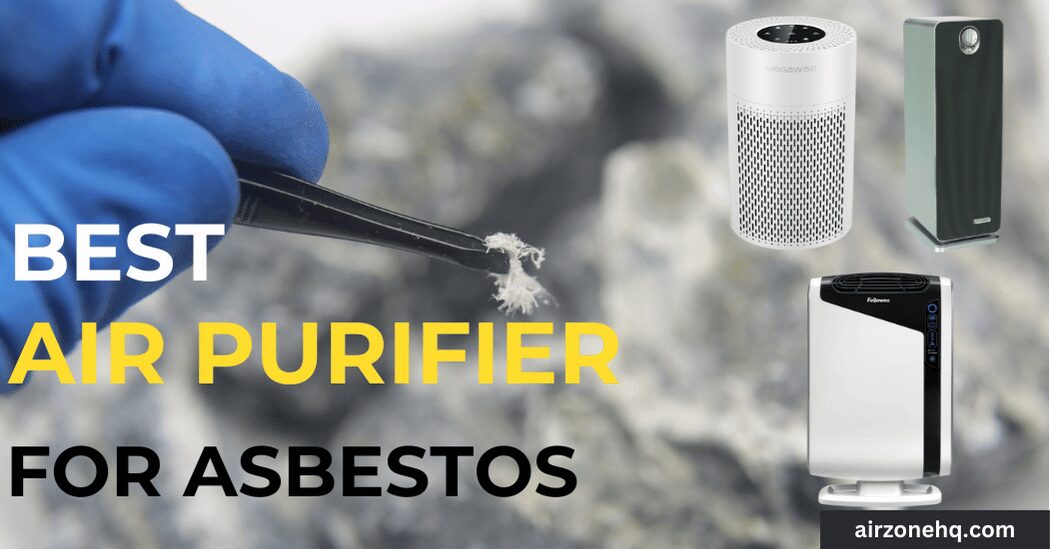
Leave a Reply